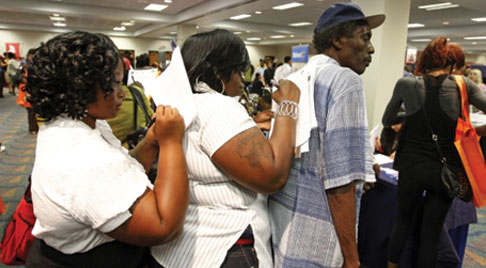
Black unemployment drops faster than for whites
By Freddie Allen
WASHINGTON, D.C. (NNPA) – The Black unemployment rate fell to 13.2 percent in November, down from 14.3 percent the previous month. The decrease of 1.1 percent was a sharper drop than for whites (6.8 percent, from 7 percent in October) and Latinos (10 percent, the same as for the previous month), according to the monthly report by the Bureau of Labor Statistics.
Overall, unemployment fell by two-tenths of a percent, to 7.7 percent in November from 7.9 percent in October.
The drop defied predictions of many economists who believed the superstorm combined with the shutdown of east coast financial centers and delayed fuel delivery to the region would have a severe impact on job growth.
The unemployment rate for Black men fell from 15.6 percent in October to 14.3 percent in November. Since June 2009, which marked the official end of the Great Recession, the rate for Black males has declined from 17.5 percent to 14.3 percent, a dip of 3.2 percent.
Black women saw their unemployment rate fall from 13.3 percent in October to 12.3 percent in November. While men enjoyed a drop of 4.2 percent since June 2009, the end of the Great Recession, the rate for Black women was virtually unchanged, from 12.7 percent in November to 12.3 percent over that same period.
Despite causing nearly $50 billion dollars in damages, the Labor Department said, “Hurricane Sandy did not substantively impact the national employment and unemployment estimates for November.”
Although the number of jobs added roughly matches the 151,000 average for the year, the number of adults working and looking for work, reflected in the labor participation rate, fell 0.2 points. The Black labor force also contracted (from 62.4 percent in October to 61.3 percent in November), despite a dramatic 1.1 percent drop in the unemployment rate to 13.2 percent in November. Economists often cite the small sample size for the month-to-month fluctuations in the unemployment rate for Blacks.
In comparison, the labor participation rate for whites was 63.7 percent and the unemployment rate was 6.8 percent roughly half the rate for Blacks.
As President Obama and Speaker of the House John Boehner, war over two percent of the population, economists recommend actions that could bring peace of mind to the 98 percent this holiday season.
In a statement on the November jobs report, Chad Stone, chief economist at the Center on Budget and Policy Priorities, a non-partisan economic research group wrote:
“Policymakers could create a much rosier outlook for jobless workers and the economy generally if they would swiftly negotiate a deal that avoids the ‘fiscal cliff’ and raises the debt limit at the same time. The deal should include a set of measures, including an extension of federal emergency unemployment insurance (UI) for another year, that help the recovery gain strength while deficit-reduction measures phase in.”
Stone added that, “A deal that does not include an ex-tension of federal emergency UI and provide other shorter-term stimulus measures would not just be cruel to jobless workers, it would make the recovery slower than it has to be.”
Stone joins a chorus of economists urging lawmakers to cut a deal that includes extending the unemployment insurance benefits.
Almost two million Americans get $1,200 a month in UI benefits. Nearly one million African Americans benefit from the program.
“That’s not a complete dead weight,” said Margaret Simms, director of Urban Institute’s Low-Income Working Families project. “People will have more money to buy groceries and pay their rent and their utilities all of which feed back into the economy.”
In a post titled, “Resilient Jobs Market Needs More Policy Help” Adam Hersh, an economist at the Center for American Progress said that President Obama’s plan will not only help families keep food on the dinner table, but also “strengthen recovery today and economic competitiveness tomorrow. “
Hersh added: “President Barack Obama offers this in his proposal to resolve the fiscal showdown, with $200 billion proposed for a payroll tax cut, expanded infrastructure investment, incentives for business investment, and renewed un-employment insurance, among other policies.”
Hersh said, that if politicians don’t act to jumpstart job growth, at the current three-month trend, it would take nearly 20 years for our economy to return to “full employment.”
